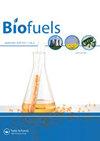甲醇、异丁醇、煤油、二甲基呋喃、乙醇和异丙醇添加剂对富氢甲烷火焰烟尘浓度的影响
IF 2.6
4区 工程技术
Q3 ENERGY & FUELS
引用次数: 0
摘要
生物燃料对烟灰形成的影响是一个令人兴奋的研究课题。为此,以富氢甲烷为主要燃料,利用激光诱导白炽灯(LII)在燃烧器中研究了不同生物燃料对的燃烧行为。对甲醇、异丁醇、煤油、二甲基呋喃、乙醇和异丙醇燃料与富氢甲烷结合的几种火焰中烟灰浓度进行了观察。测定了添加剂燃料的烟尘浓度,考察了火焰中烟尘颗粒和雷诺数对火焰振荡和烟尘相互作用的影响。h-甲烷+煤油中形成的煤烟最多,形成较大的煤烟分形聚集体。异丁醇对振荡的Re灵敏度比异丙醇对烟灰浓度的Re灵敏度高8.8%。此外,随着Re的增加,异丁醇产生的烟灰量也会增加。与煤油相比,使用二甲基呋喃时火焰面积/烟尘面积比降低速度快1.7倍。二甲基呋喃在火焰中产生的烟尘场比甲醇高23.9%,比乙醇高25.9%。实验结果表明,在富氢甲烷火焰中加入异丙醇时烟尘浓度最低。本文章由计算机程序翻译,如有差异,请以英文原文为准。
Methanol, isobutanol, kerosene, dimethylfuran, ethanol, and isopropanol additives effects on soot concentration at hydrogen-enriched methane flames
Abstract One exciting research topic is biofuels’ effects on soot formation. For this purpose, the combustion behavior of different biofuel pairs, with the main fuel being hydrogen-enriched methane, was investigated in a burner, using laser-induced incandescence (LII). The soot concentrations in several flames were observed for methanol, isobutanol, kerosene, dimethylfuran, ethanol, and isopropanol fuels coupled with hydrogen-enriched methane. Soot concentration was determined for the additive fuels and the effects of soot particles in the flame and Reynolds number on the flame oscillation and soot interaction were examined. The highest soot formation was observed in the h-methane + kerosene and led to large soot fractal aggregates. The isobutanol has 8.8% higher Re sensitivity for oscillation than isopropanol for soot concentration. Also, isobutanol causes a higher amount of soot production as Re increases. The flame area/soot area ratio decreases 1.7 times faster with dimethylfuran usage compared to kerosene. The dimethylfuran created a higher soot field in the flame by 23.9% compared to methanol and 25.9% compared to ethanol. At the tests, the lowest soot concentration was observed in the addition of isopropanol in hydrogen-enriched methane flame.
求助全文
通过发布文献求助,成功后即可免费获取论文全文。
去求助
来源期刊

Biofuels-Uk
Energy-Renewable Energy, Sustainability and the Environment
CiteScore
5.40
自引率
9.50%
发文量
56
期刊介绍:
Current energy systems need a vast transformation to meet the key demands of the 21st century: reduced environmental impact, economic viability and efficiency. An essential part of this energy revolution is bioenergy.
The movement towards widespread implementation of first generation biofuels is still in its infancy, requiring continued evaluation and improvement to be fully realised. Problems with current bioenergy strategies, for example competition over land use for food crops, do not yet have satisfactory solutions. The second generation of biofuels, based around cellulosic ethanol, are now in development and are opening up new possibilities for future energy generation. Recent advances in genetics have pioneered research into designer fuels and sources such as algae have been revealed as untapped bioenergy resources.
As global energy requirements change and grow, it is crucial that all aspects of the bioenergy production process are streamlined and improved, from the design of more efficient biorefineries to research into biohydrogen as an energy carrier. Current energy infrastructures need to be adapted and changed to fulfil the promises of biomass for power generation.
Biofuels provides a forum for all stakeholders in the bioenergy sector, featuring review articles, original research, commentaries, news, research and development spotlights, interviews with key opinion leaders and much more, with a view to establishing an international community of bioenergy communication.
As biofuel research continues at an unprecedented rate, the development of new feedstocks and improvements in bioenergy production processes provide the key to the transformation of biomass into a global energy resource. With the twin threats of climate change and depleted fossil fuel reserves looming, it is vitally important that research communities are mobilized to fully realize the potential of bioenergy.
 求助内容:
求助内容: 应助结果提醒方式:
应助结果提醒方式:


